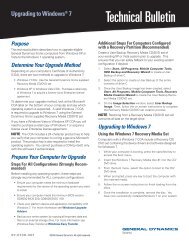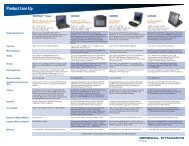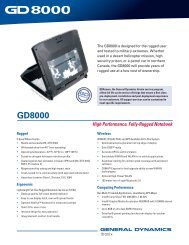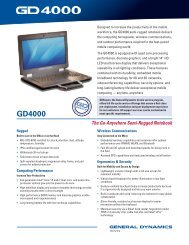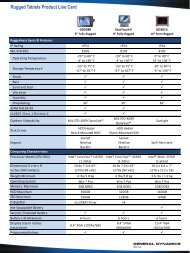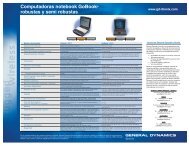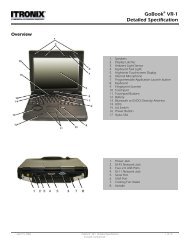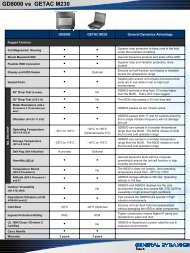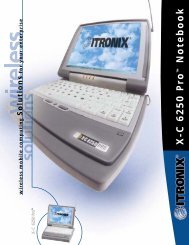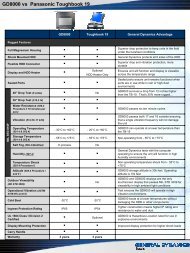lighting, aircraft, night vision imaging system - General Dynamics ...
lighting, aircraft, night vision imaging system - General Dynamics ...
lighting, aircraft, night vision imaging system - General Dynamics ...
Create successful ePaper yourself
Turn your PDF publications into a flip-book with our unique Google optimized e-Paper software.
MIL-STD-3009<br />
3.7 CIE color coordinate <strong>system</strong>.<br />
The fundamental definitions of color are expressed in terms of the “standard observer”<br />
and coordinate <strong>system</strong> adopted by the International Commission on Illumination (C.I.E.)<br />
at Cambridge, England, in 1931 and published in the Journal of the Optical Society of<br />
America, Vol. 23, page 359, October 1933. Wherever chromaticity coordinates (x, y, z)<br />
appear in this document, they relate to this <strong>system</strong>. The CIE 1976 uniform chromaticity<br />
scale (UCS) diagram is the CIE 1931 chromaticity diagram redrawn with the x and y<br />
axes subjected to a linear transformation as defined in CIE Publication 15, Supplement<br />
2, 1978.<br />
3.8 NVIS radiance.<br />
NVIS radiance is the amount of energy emitted by a light source that is visible through<br />
NVIS. NVIS radiance is defined as the integral of the curve generated by multiplying<br />
the spectral radiance of a light source by the relative spectral response of the NVIS<br />
defined in TABLE III or TABLE III.a, as appropriate.<br />
3.9 Rated drive condition.<br />
Rated drive condition(s) are the electrical power state(s) obtained by conformance to<br />
the allowable electrical characteristics (voltage, current, pulse width modulation,<br />
frequency, etc.) in MIL-STD-704 for the various <strong>lighting</strong> components or <strong>system</strong>s in<br />
meeting specified <strong>lighting</strong> levels.<br />
3.10 Light leaks.<br />
Visual evidence through the NVIS of light emitted from a component from areas that are<br />
not intended to be illuminated (non-compatible unfiltered light leaks).<br />
3.11 Contrast vs. contrast ratio.<br />
Contrast (CL, CI and CUL), as specified in this document, is one less than contrast ratio,<br />
which is defined as L2/L1 in some specifications.<br />
3.12 Electronic and/or electro-optical displays.<br />
All displays capable of presenting a variety of different images on their screen; the<br />
displayed portrayals being generated through direct electronic modulation or through<br />
indirect electro-optical modulation of emitted, transmitted, or reflected light luminance<br />
levels, contrasts, and/or chromaticities. These displays may present characters,<br />
numerals, symbols, graphics, or video. They are based on a CRT, a dot matrix<br />
technology, or a segmented design, and may, or may not be, capable of portraying<br />
shades of gray.<br />
3.13 IR mode.<br />
The infrared (IR) or covert mode for exterior <strong>lighting</strong> is defined as not viewable by a<br />
dark-adapted, unaided eye at a distance greater than 30 feet, in the dark (i.e., less than<br />
1.0 footcandle ambient illumination), and when the <strong>system</strong> is on the ground. The mode<br />
shall be viewable by NVIS at minimum distance of 3 NM in the air, at <strong>night</strong>, with a ¾ to<br />
full moon, and with all other <strong>system</strong> exterior lights off. “Lower hemisphere” shall be<br />
defined as not viewable by an NVIS equipped ground or aerial observer when the<br />
<strong>system</strong> is directly overhead, straight and level, and at 300 to 500 feet away.<br />
6





